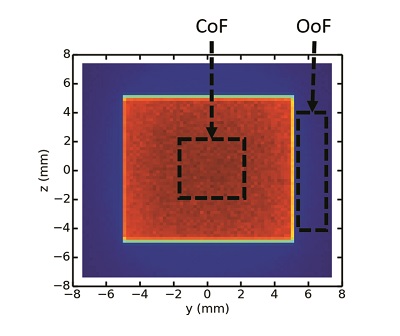 Microbeam radiation therapy (MRT) is an innovative preclinical radiotherapy procedure consisting of many micrometre-sized spatially fractionated radiation fields, obtained by collimating a beam of synchrotron radiation with a multi-slit collimator. A typical radiation field of MRT consists of an array of microbeams, each with a width of 50 µm and a centre-to-centre distance of 400 µm.
Microbeam radiation therapy (MRT) is an innovative preclinical radiotherapy procedure consisting of many micrometre-sized spatially fractionated radiation fields, obtained by collimating a beam of synchrotron radiation with a multi-slit collimator. A typical radiation field of MRT consists of an array of microbeams, each with a width of 50 µm and a centre-to-centre distance of 400 µm.
MRT differs from external beam radiation therapy (EBRT) due to the properties of synchrotron radiation, such as the small angular divergence of the photon beam, the broad spectrum of energies available and the pulsed high-intensity radiation that is produced. The low divergence of the beam ensures that the field does not spread out as it passes through the patient, thus maintaining the spatial fractionation at depth; the high-intensity radiation allows treatment time to be reduced, thus reducing smearing of the microbeam paths in the tissues due to breathing or cardiosynchronous motion.
The most significant advantage of MRT over EBRT is the different radiobiological response of cancerous and healthy tissues to the micrometre-sized MRT field. As the size of the radiation field decreases to the order of micrometres the dose tolerated by normal tissue increases dramatically, whilst maintaining tumour control. This phenomenon, called the dose-volume effect, makes MRT a promising treatment for radioresistant tumours such as osteosarcomas, or tumours located within or near sensitive structures (e.g. glioblastomas in paediatric patients).
Routine dosimetry quality assurance (QA) prior to treatment is necessary to identify any changes in beam condition from the treatment plan, and is undertaken using solid homogeneous phantoms. Solid phantoms are designed for, and routinely used in, megavoltage X-ray beam radiation therapy. These solid phantoms are not necessarily designed to be water-equivalent at low X-ray energies, and therefore may not be suitable for MRT QA.
Cameron et al. (2017). J. Synchrotron Rad. 24, 866-876 simulated dose profiles of various phantom materials and compared them with those calculated in water under the same conditions, so demonstrating quantitatively the most appropriate solid phantom to use in dosimetric MRT QA.
Based on the study, the adoption of virtual water, plastic water DT, RW3 and RM1457 solid water were recommended for MRT QA as water-equivalent solid phantom materials.
